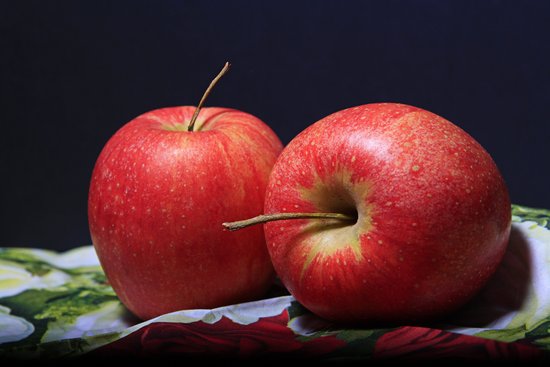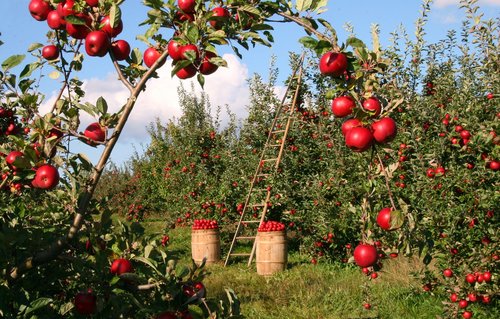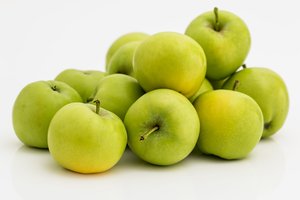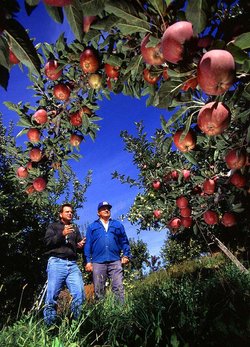Apple
|
|
The apple is the pomaceous fruit of plants of the genus Malus in the family Rosaceae, and is one of the most widely cultivated tree fruits. Table apples are of the species M. domestica or hybrids of it.
| Contents |
|
|
Apples: From Ancient Orchards to Modern Markets
Apples are one of the most popular fruits in the world. They come in many colors, flavors, and sizes, and are grown in orchards on every continent except Antarctica. Known for their sweet or tangy taste and satisfying crunch, apples are not just a tasty snack—they also have a long history, play a role in cultures around the world, and offer important health benefits.
What Is an Apple?
An apple is a type of fruit known as a pome. It grows on trees in the Malus genus, part of the Rosaceae, or rose family. The most common kind of apple is Malus domestica. There are over 7,500 different types of apples, called cultivars, each with its own flavor, color, and use.
Some apples are grown to be eaten fresh (these are called dessert apples), while others are used for cooking or making drinks like apple cider.
Where Apples Come From
Botanical Origins
The modern apple we know today came from a wild apple species called Malus sieversii. This tree still grows in the mountains of Central Asia, in countries like Kazakhstan, China, and Kyrgyzstan. These wild apples are being studied by scientists because they are naturally resistant to diseases and pests, which helps improve today's apples.
Although people once believed other wild apple species also helped create the modern apple, newer studies show that Malus sieversii is the main ancestor.
A History of Apple Growing
Apples have been important for thousands of years, especially in colder climates. They store well through winter and were likely one of the first trees ever grown for food. People in Europe, Asia, and later the United States have all relied on apples as a nutritious part of their diets.
Types of Apples
There are thousands of apple types around the world, and each one is suited to different climates and uses. Popular varieties today include:
- Fuji – very sweet and crisp
- Gala – mild, sweet flavor
- Granny Smith – tart and crunchy
- Honeycrisp – very juicy with a perfect sweet-tart balance
Old-fashioned varieties may look odd but often have rich, unique flavors. Many of these heirloom apples are preserved by small farms and backyard growers.
📸 Visual aid suggestion: Photos comparing modern vs heirloom apples.
How Apples Are Grown
Breeding and Propagation
Apple trees are not usually grown from seeds because the offspring may be very different from the parent. Instead, apples are grafted. This means a branch from one tree (called a scion) is attached to the roots of another tree (rootstock). The rootstock helps control the tree's size and strength.
Some apple varieties, like Honeycrisp, were created by scientists through careful cross-breeding to make them tastier, hardier, or better for storage.
Starting an Orchard
Apple trees are usually planted when they are two or three years old. Depending on the rootstock, trees may grow to full size or stay smaller. Smaller trees are easier to pick and can be planted closer together.
It can take 3–10 years before a tree begins to produce a good crop of apples.
📸 Visual aid suggestion: Diagram showing apple tree grafting and orchard planting.
Pollination and Flowering
Apples need help from insects like honeybees to produce fruit. This is because apples cannot pollinate themselves—they must be cross-pollinated by pollen from a different type of apple tree. Orchard owners often place beehives in their fields to help with this.
Bad weather during the blooming season or not having the right mix of trees can result in poor pollination. Without enough pollen, apples may grow small, be oddly shaped, or fall off the tree early.
Apple Pests and Diseases
Growing apples isn’t easy. Apple trees can get diseases like:
- Fireblight (a bacterial disease)
- Apple scab (a fungal infection)
- Rusts and black spot
They’re also attacked by insects like the codling moth, apple maggot, and others. To protect the fruit, many farmers use careful spraying methods, especially Integrated Pest Management (IPM), which uses fewer chemicals and promotes natural pest control.
Organic apple farming is challenging, but some farmers succeed using disease-resistant types and natural methods like spraying kaolin clay to block insects.
Harvest Time
When apple trees are mature, they can produce between 100 and 200 kilograms of fruit every year! Apples are usually picked by hand using special ladders to avoid bruising the fruit.
Dwarf trees (smaller trees) are easier to pick from and often grown in “high-density” orchards for better efficiency.
What Happens After Harvest
Apples are eaten fresh or used in many foods and drinks. They can be:
- Cooked – in pies, crumbles, and stews
- Dried – for snacks or baking
- Juiced – to make apple juice or cider
- Fermented – for vinegar, cider, or spirits like Calvados
In many cultures, apples are tied to traditions and celebrations. For example, apples are dipped in honey during Rosh Hashanah, the Jewish New Year, to symbolize a sweet year ahead.
Health Benefits of Apples
The saying “an apple a day keeps the doctor away” has some truth to it. Apples are full of fiber, vitamin C, and antioxidants called polyphenols. These nutrients:
- Support a healthy heart
- Help control cholesterol
- May reduce cancer risk
- Support brain health and memory
Eating apples regularly can also help with weight management and digestion.
Apples in Culture
- The apple blossom is the state flower of Arkansas.
- William Tell, a Swiss folk hero, is said to have shot an apple off his son’s head with a crossbow.
- In some cultures, apples are believed to have magical or romantic powers.
- In the U.S., a shiny red apple is a traditional gift for a teacher.
Fun Facts About Apples
- The world grows more than 80 million tons of apples every year.
- China is the world’s top apple producer.
- There are over 7,500 different types of apples!
- Apples float in water because they are 25% air.
- The science of growing apples is called pomology.
- Apple trees can live for more than 100 years.
- The first American apple orchard was planted in 1625 in Boston.
- Apples belong to the same family as roses.
Botanical origins
The wild ancestor of Malus domestica is Malus sieversii (which has no common name), a tree still found wild in the mountains of Central Asia in southern Kazakhstan, Kyrgyzstan, Tajikistan, and Xinjiang, China. M. sieversii resists many diseases and pests that affect domestic apples, and research with it to develop new disease-resistant apples is continuing.
Other species that were previously thought to have made contributions to the genome of the domestic apples are Malus baccata and Malus sylvestris, but there is no hard evidence for this in older apple cultivars. These and other Malus species have been used in some recent breeding programs to develop apples suitable for growing in climates unsuitable for M. domestica, mainly for increased cold tolerance.
Apples have been a very important food in all cooler climates, and it was probably the earliest tree to be cultivated. To a greater degree than other tree fruit, except possibly citrus, apples store for months while still retaining much of their nutritive value. Winter apples, picked in late autumn and stored just above freezing have been an important food in Asia and Europe for millennia, as well as in the United States since the arrival of Europeans.
Apple cultivars
There are more than 7,500 known cultivars of apples. Different cultivars are available for temperate and subtropical climates. Apples do not flower in tropical climates because they have a chilling requirement.
Commercially-popular apple cultivars are soft but crisp. Other desired qualities in modern commercial apple breeding are a colorful skin, absence of russeting, ease of shipping, lengthy storage ability, high yields, disease resistance, typical 'Red Delicious' apple shape, long stem (to allow pesticides to penetrate the top of the fruit), and popular flavor.
Old cultivars are often oddly shaped, russeted, and have a variety of textures and colors. Many of them have excellent flavor (often better than most modern cultivars), but may have other problems which make them commercially unviable, such as low yield, liability to disease, or poor tolerance for storage or transport. Few old cultivars are still produced on a large scale, but many have been kept alive by home gardeners and farmers that sell directly to local markets. Many unusual and locally important cultivars with their own unique flavor and appearance are out there to discover; apple conservation campaigns have sprung up around the world to preserve such local heirlooms from extinction.
Although most cultivars are bred for eating fresh (dessert apples), some are cultivated specifically for cooking (cooking apples) or producing cider. Cider apples are typically too tart and astringent to eat fresh, but they give the beverage a rich flavor that dessert apples cannot.
Flavors of apples
Modern apples are, as a rule, sweeter than older cultivars. Most North Americans and Europeans favor sweet, subacid apples, but tart apples have a strong minority following. Extremely sweet apples with barely any acid flavor are popular in Asia.
Tastes in apples vary from one person to another and have changed over time. As an example, the U.S. state of Washington made its reputation for apple growing on Red Delicious. In recent years, many American apple connoisseurs regard Red Delicious as inferior to varieties such as Fuji and Gala due to the mild flavor and soft texture of the Red Delicious.
Growing apples
- Apple breeding
Like most perennial fruits, apples are ordinarily propagated asexually by grafting. Seedling apples are different from their parents, sometimes radically. Most new apple cultivars originate as seedlings, which either arise by chance or are bred by deliberately crossing cultivars with promising characteristics. The words seedling, pippin, and kernel in the name of an apple cultivar suggest that it originated as a seedling. Apples can also form bud sports (mutations on a single branch). Some bud sports turn out to be improved strains of the parent cultivar. Some differ sufficiently from the parent tree to be considered new cultivars.
Some breeders have crossed ordinary apples with crabapples or unusually hardy apples in order to produce hardier cultivars. For example, the Excelsior Experiment Station of the University of Minnesota has, since the 1930s, introduced a steady progression of important hardy apples that are widely grown, both commercially and by backyard orchardists, throughout Minnesota and Wisconsin. Its most important introductions have included Haralson (which is the most widely cultivated apple in Minnesota), Wealthy, Honeygold, and Honeycrisp. The sweetness and texture of Honeycrisp have been so popular with consumers that Minnesota orchards have been cutting down their established, productive trees to make room for it, a heretofore unheard of practice.
- Starting an orchard
Apple orchards are established by planting two or three year old trees. These small trees are usually purchased from a nursery where they are produced by grafting or budding. First, a rootstock is produced either as a seedling or cloned using tissue culture or layering. This is allowed to grow for a year. Then, a small section of branch called a scion is obtained from a mature apple tree of the desired cultivar. The upper stem and branches of the rootstock are cut away and replaced with the scion. In time, the two sections grow together and produce a healthy tree.
Rootstocks affect the ultimate size of the tree. While many rootstocks are available to commercial grower, those sold to homeowners who want just a few trees are usually one of two cultivars: a standard seedling rootstock that gives a full-size tree, or a semi-dwarf rootstock that produces a somewhat smaller tree. Dwarf rootstocks are generally more susceptible to damage from wind and cold. Full dwarf trees are often supported of posts or trellises and planted in high density orchards which are much simpler to culture and greatly increase productivity per unit of land.
Some trees are produced with a dwarfing "interstem" between a standard rootstock and the tree, resulting in two grafts.
After the small tree is planted in the orchard, it must grow for 3-5 years (semi-dwarf) or 4-10 years (standard trees) before it will bear sizeable amounts of fruit. Good training of limbs and careful nipping of buds growing in the wrong places, are extremely important during this time, to build a good scaffold that will later support a fruit load.
- Location
Apples are relatively indifferent to soil conditions and will grow in a wide range of pH values and fertility levels. They do require some protection from the wind and should not be planted in low areas that are prone to late spring frosts. Apples do require good drainage, and heavy soils or flat land should be tiled to make certain that the root systems are never in saturated soil.
- Pollination
Apples are self-incompatible and must be cross-pollinated to develop fruit. Pollination management is an important component of apple culture. Before planting, it is important to arrange for pollenizers, cultivars of apple or crab apple that provide plentiful, viable and compatible pollen. Orchard blocks may alternate rows of compatible cultivars or may have periodic crab apple trees, or grafted-on limbs of crab apple. Some cultivars produce very little pollen, or the pollen is sterile, so these are not good pollenizers. Quality nurseries have pollenizer compatibility lists.
Growers with old orchard blocks of single cultivars sometimes provide bouquets of crab apple blossoms in drums or pails in the orchard for pollenizers. Home growers with a single tree and no other cultivars in the neighborhood can do the same on a smaller scale.
During the flowering each season, apple growers usually provide pollinators to carry the pollen. Honeybee hives are most commonly used, and arrangements may be made with a commercial beekeeper who supplies hives for a fee. Orchard mason bees are also used as supplemental pollinators in commercial orchards. Home growers may find these more acceptable in suburban locations because they do not sting. Some wild bees such as carpenter bees and other solitary bees may help. Bumble bee queens are sometimes present in orchards, but not usually in enough quantity to be significant pollinators.
Symptoms of inadequate pollination are small and misshapen apples, slowness to ripen, and low seed count. Well pollinated apples are the best quality and will have 7 to 10 seeds. Apples having less than 3 seeds will usually not mature and will drop from the trees in the early summer. Inadequate pollination can result from either a lack of pollinators or pollenizers or from poor pollinating weather at flowering time. It generally requires multiple bee visits to deliver sufficient grains of pollen to accomplish complete pollination.
A common problem is a late frost that destroys the delicate outer structures of the flower. It is best to plant apples on a slope for air drainage, but not on a south facing slope (in the northern hemisphere) as this will encourage early flowering and increase susceptibility to frost. If the frost is not too severe, the tree can be wetted with water spray before the morning sun hits the flowers, and it may save them. Frost damage can be evaluated 24 hours after the frost. If the pistil has turned black, the flower is ruined and will not produce fruit.
Growing apples near a body of water gives an advantage by slowing spring warm up, which retards flowering until frost is less likely. Areas of the USA, such as the eastern shore of Lake Michigan, the southern shore of Lake Ontario, and around some smaller lakes, where this cooling effect of water, combined with good, well-drained soils, has made apple growing concentrations possible in these areas.
Home growers may not have a body of water to help, but can utilize north slopes or other geographical features to retard spring flowering. Apples (or any fruit) planted on a south facing slope in the northern hemisphere (or north facing in the southern hemisphere), will flower early and be particularly vulnerable to spring frost.
- Thinning
Apples are prone to biennial bearing. If the fruit is not thinned when the tree carries a large crop, it may produce very little flower the following year. Good thinning helps even out the cycle, so that a reasonable crop can be grown every year.
- Pests and diseases
The trees are susceptible to a number of fungal and bacterial diseases and insect pests. Nearly all commercial orchards pursue an aggressive program of chemical sprays to maintain high fruit quality, tree health, and high yields. A trend in orchard management is the use of Integrated Pest Management (IPM), which reduces needless spraying when pests are not present, or more likely, are being controlled by natural predators.
Spraying for insect pests must never be done during flowering because it kills pollinators. Nor should bee-attractive plants be allowed to establish in the orchard floor if insecticides are used. White clover is a component of many grass seed mixes, and many bees are poisoned by insecticides while visiting the flowers on the orchard floor.
Among the most serious disease problems are fireblight, a bacterial disease; and Gymnosporangium rust, apple scab, and black spot, three fungal diseases.
The plum curculio is the most serious insect pest. Others include Apple Maggot, codling moth, Emperor Moth, November Moth, Winter Moth, Green Pug, Brimstone Moth, Poplar Hawk-moth, Coxcomb Prominent, Yellow-tail and Short-cloaked Moth.
In Australia, introduced apple trees are sometimes used as food plants by the larvae of hepialid moths of the genus Aenetus. These burrow horizontally into the trunk then vertically down.
Apples are difficult to grow organically, though a few orchards have done so with commercial success, using disease-resistant cultivars and the very best cultural controls. The latest tool in the organic repertoire is to spray a light coating of kaolin clay, which forms a physical barrier to some pests, and also helps prevent apple sun scald.
- Harvest
Mature trees typically bear 100-200 kg (5-10 bushels) of apples each year. Apples are harvested using three-point ladders that are designed to fit amongst the branches. A few cultivars left unpruned, will grow to be extremely large, causing them to bear a great deal of fruit that is difficult to harvest. Dwarf trees will bear about 50-100 kg (3-5 bushels) of fruit per year.
Cultivars vary in their yield and the ultimate size of the tree, even when grown on the same rootstock.
Commerce and uses
45 million metric tons of apples were grown worldwide in 2002, with a value of about 10 billion USD. China produced almost half of this total. The United States is the second leading producer, accounting for 10% of world production. Turkey is also a leading producer. France, Italy, South Africa and Chile are among the leading apple exporters.
In the United States, more than 60% of all the apples sold commercially are grown in Washington state. Imported apples from New Zealand and other more temperate areas are competing with US production and increasing each year.
Apples can be canned, juiced, and optionally fermented to produce apple juice, cider, vinegar, and pectin. Distilled apple cider produces the spirits applejack and Calvados. Apple wine can also be made.
Apples are an important ingredient in many winter desserts, for example apple pie, apple crumble and apple cake. They are often eaten baked or stewed, and they can also be dried and eaten or re-constituted (soaked in water, alcohol or some other liquid) for later use. Pur饤 apples are generally known as apple sauce. Apples are also made into apple butter and apple jelly. They are also used cooked in meat dishes.
In the UK, a toffee apple is a traditional confection made by coating an apple in hot toffee and allowing it to cool. Similar treats in the US are candy apples (coated in a hard shell of crystallized sugar syrup), and caramel apples, coated with cooled caramel.
Apples are eaten with honey at the Jewish New Year of Rosh Hashanah to symbolize a sweet new year.
Health benefits
Apples have long been considered healthy, as indicated by the proverb an apple a day keeps the doctor away. In practice apples have been proven to reduce the risk of colon cancer, prostate cancer and lung cancer. They can also help with heart disease, weight loss and controlling cholesterol.
A group of chemicals in apples could protect the brain from the type of damage that triggers such neurodegenerative diseases as Alzheimer's and Parkinsonism. Chang Y. "Cy" Lee of Cornell University found that the apple phenolics, which are naturally occurring antioxidants found in fresh apples, can protect nerve cells from neurotoxicity induced by oxidative stress. The researchers used red delicious apples grown in New York state to provide the extracts to study the effects of phytochemicals. Lee said that all apples are high in the critical phytonutrients and that the amount of phenolic compounds in the apple flesh and in the skin vary from year to year, season to season and from growing region to growing region (November/December 2004 issue of the Journal of Food Science).
Cultural aspects
- Apples as symbols
.
The apple blossom is the state flower of Arkansas.
- Traditions
Swiss folklore holds that William Tell courageously shot an apple from his son's head with his crossbow, defying a tyrannical ruler and bringing freedom to his people.
Irish folklore claims that if an apple is peeled into one continuous ribbon and thrown behind a woman's shoulder, it will land in the shape of the future husband's initials. Danish folklore says that apples wither around adulterers.
In some places, dunking for apples is a traditional Halloween activity. Apples are said to increase a woman's chances of conception as well as remove birthmarks when rubbed on the skin. In the United States, Denmark and Sweden, an apple (polished) is a traditional gift for a teacher.
| Apple | ||||||||||||||
|---|---|---|---|---|---|---|---|---|---|---|---|---|---|---|
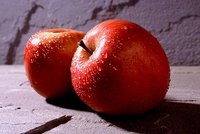 Fuji apple | ||||||||||||||
| Scientific classification | ||||||||||||||
|
common cultivars
The following is a list of common cultivars and where they are grown. The year and place of origin is also listed:
- 'Braeburn': New Zealand (1950s), United States
- 'Bramley': Southwell, Nottinghamshire, England (about 1809)
- 'Cameo': Washington (1980s)
- 'Cortland': New York (late 1890s)
- 'Cox's Orange Pippin': Great Britain, New Zealand
- 'Duchess of Oldenburg': Russia (1700)
- 'Egremont Russet': Sussex, Britain (1872)
- 'Empire': New York (1966)
- 'Fuji': Japan (1930s), Asia, Australia
- 'Gala': New Zealand (1970s), United States
- 'Ginger Gold': Virginia (late 1960s)
- 'Golden Delicious': United States (1890), Europe
- 'Granny Smith': Australia (1868), California)
- 'Haralson (apple)': Minnesota (1923)
- 'Honeycrisp': Minnesota (1960)
- 'Idared': Idaho (1942)
- 'James Grieve': Edinburgh (1893)
- 'Jonagold': New York (1968), elsewhere in United States
- 'Jonathan': New York (1920s), elsewhere in United States
- 'Lodi': Ohio
- 'McIntosh': Canada (1811)
- 'Newtown Pippin': New York (1759), Oregon
- 'Pink Lady': Australia (early 1970s), western United States
- 'Pinova': Germany (1986)
- 'Red Delicious': Iowa (1870s), elsewhere in United States
- 'Ribston Pippin: Yorkshire, Great Britain (1707)
- 'Rome Beauty': Ohio (early 1800s)
- 'Royal Gala': New Zealand (c.1960)
- 'Spartan': British Columbia (1926)
- 'Winesap': United States
- 'Worcester Pearmain': Worcestershire (1873)


